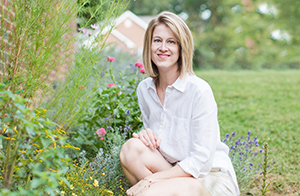Last year, I expanded my raised bed garden. My plan was to garden in-ground this time to save money and to try something different. Once we got into the project, I realized that plan wouldn’t work. My garden is on a gentle slope that seemed harmless before, but once I saw it cleared, I knew that water run-off would be a problem and that I wouldn’t be able to get the soil and mulch to stay in place without washing away. So, I set off to figure out how to terrace the garden space. I couldn’t find much information, so I thought I would share what I did to build my terraced raised beds.
The process boiled down to these two things:
1) A lot of hard work digging
2) building mainly three or four-sided raised beds to tuck into the slope
Terraced Beds or Terraced Raised Beds?
At first, I was planning to terrace the slope and use either one board or even a three-sided structure to terrace in-ground. But, because I would have to brace three sides, I decided to go ahead and build up to raise them a little bit because I chickened out on completely going in-ground due to my poor clay soil.
The photo below was my original idea. Use a board on the low end to level it out.
Terraced Raised Bed Materials
The main thing that tripped me up was figuring out what material to use to build the sides of the beds. I try to garden as organically as possible, so using treated wood was a no-go for me. As was using regular pine that would rot in no time. The perfect choice was cedar, of course. However, dimensional cedar is extremely hard to find for me here in southwest Virginia and it’s very expensive in general. What you find for cedar is thin siding material or more finished pieces for interior use. I asked around and called so many places. I also kept checking the big box stores and finally one day I found some 2×4-10s at a Lowe’s about 40 minutes away. So, I quickly reserved them online.
I also considered stone block, but after doing a deep dive on those, I discovered that they used to be made using fly ash, which is a by-product of pulverized coal and not good at all for organic gardening. Most of them aren’t made with that any more, but it was hard to get straight answers from vendors. Plus, the stone block is expensive, too.
Other good options would be natural stone or felled logs.
I ended up with a bunch of cedar 2x4s and my dad gave us some leftover cedar siding boards.
Building the Terraced Raised Beds on a Slope
We started at the top of the slope that was the most flat and worked our way down.

The first thing I did was use stakes and twine to mark out where the beds would go.

Then, we would lay out the boards where we wanted them. Then, it was a back-and-forth process of building the raised beds in place and digging out spots with the Mattock pick axe to make everything level.

We screwed them together and used small pieces to brace the interior. The idea was to make the high side (back side towards the fence) level with the new raised side. They are all deeper on the side going down the slope.

Each time a bed was finished, we had to take dirt we were digging from the bed areas and use it build up and level out the paths that had to be completely flat. This was hard manual labor.

The photo below shows this bed almost done. We had to dig to fit that last upper support board in. Then, I dug out all of the dirt on the high side so that I would be able to fill it instead with topsoil and compost. It was hard work with the pick axe to dig out that hard compacted soil. We ran out of the thick 2x4s and had to use the thinner cedar for some of the beds. Not ideal, and it bows, but it works. You can see how the boards by the fence are built into the slope and that 2 boards were used on one long side and only one on the other side.

The final board is in place and most of the digging inside is done.

The last step was to fill the beds with a mix of topsoil and compost.
Views of the finished product: terraced raised beds




Things you will need

Grow with me
See my other garden or wildlife posts.
Get new posts in your inbox by subscribing.
Follow on Instagram.





1 Comment
Nice job! Good use of space; working in clay is never a “fun” time; adapted the plans as you went along – great job!